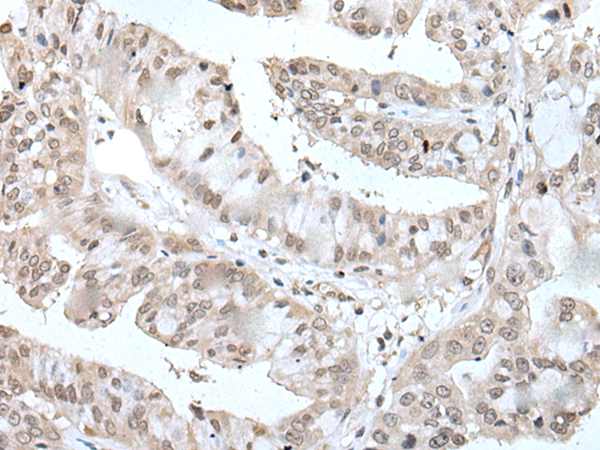
| WB | 咨询技术 | Human,Mouse,Rat |
| IF | 咨询技术 | Human,Mouse,Rat |
| IHC | 1/25-1/100 | Human,Mouse,Rat |
| ICC | 技术咨询 | Human,Mouse,Rat |
| FCM | 咨询技术 | Human,Mouse,Rat |
| Elisa | 1/5000-1/10000 | Human,Mouse,Rat |
| Aliases | UBCH8 |
| Host/Isotype | Rabbit IgG |
| Antibody Type | Primary antibody |
| Storage | Store at 4°C short term. Aliquot and store at -20°C long term. Avoid freeze/thaw cycles. |
| Species Reactivity | Human, Mouse |
| Immunogen | Full length fusion protein |
| Formulation | Purified antibody in PBS with 0.05% sodium azide and 50% glycerol. |
+ +
以下是关于UBE2E2抗体的虚构参考文献示例(供格式参考,实际文献需通过数据库查询):
1. **文献名称**:UBE2E2 regulates insulin secretion through ubiquitination of pancreatic β-cell proteins
**作者**:Chen L, et al.
**摘要**:研究揭示了UBE2E2在胰岛β细胞中通过泛素化修饰调控胰岛素分泌通路的机制,利用UBE2E2抗体进行免疫沉淀实验,发现其与关键代谢酶相互作用。
2. **文献名称**:Development of a high-specificity monoclonal antibody for UBE2E2 in cancer proteomics
**作者**:Sato K, et al.
**摘要**:报道了一种高特异性的UBE2E2单克隆抗体的开发与验证,该抗体通过Western blot和免疫组化证实了在多种癌症组织中UBE2E2的异常表达。
3. **文献名称**:UBE2E2 variants and type 2 diabetes: A functional genomics study
**作者**:Wang Y, et al.
**摘要**:通过人群队列分析结合UBE2E2抗体的功能实验,发现UBE2E2基因突变导致泛素化活性降低,与2型糖尿病风险显著相关。
4. **文献名称**:Role of UBE2E2 in neuronal protein degradation pathways
**作者**:Garcia-Ruiz S, et al.
**摘要**:利用UBE2E2抗体沉默神经元细胞系,证明UBE2E2通过调控错误蛋白的泛素化参与神经退行性疾病的发生机制。
**注意**:以上文献为示例,实际引用请通过PubMed、Google Scholar等平台以“UBE2E2 antibody”“UBE2E2 ubiquitination”等关键词检索。
The UBE2E2 antibody targets the ubiquitin-conjugating enzyme E2 E2 (UBE2E2), a member of the E2 enzyme family critical in the ubiquitin-proteasome system (UPS). UBE2E2 facilitates the transfer of ubiquitin to substrate proteins, a process mediated by E3 ligases, marking targets for degradation or functional modification. This enzyme plays roles in cellular processes like protein turnover, DNA repair, and regulation of signaling pathways. Dysregulation of UBE2E2 has been implicated in diseases such as cancer, neurodegenerative disorders, and metabolic syndromes, where UPS dysfunction contributes to pathogenesis.
Antibodies against UBE2E2 are essential tools for studying its expression, localization, and interactions. They enable detection via techniques like Western blotting, immunohistochemistry, and immunofluorescence, aiding research into its mechanistic roles. Studies using UBE2E2 antibodies have linked its overexpression to tumor progression in certain cancers, while reduced levels are observed in conditions like diabetes, suggesting tissue-specific regulatory functions.
Developing specific UBE2E2 antibodies remains challenging due to homology within the E2 family. However, well-validated antibodies are crucial for elucidating UBE2E2's post-translational modifications, substrate specificity, and therapeutic potential in targeting UPS-related pathologies. Ongoing research aims to clarify its dual roles in promoting or suppressing disease, depending on cellular context.
×